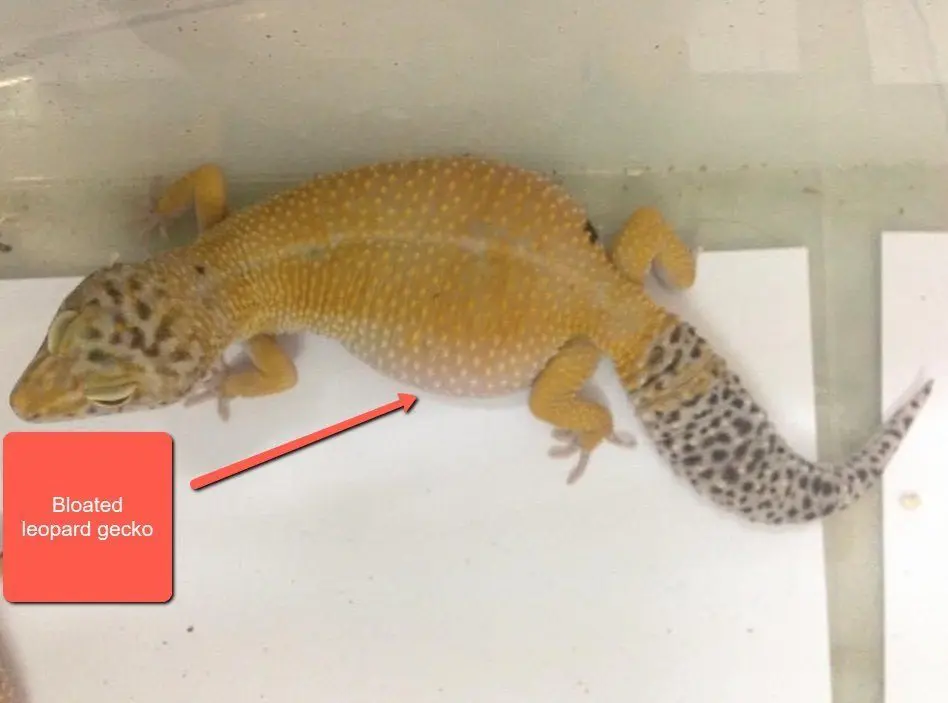Being a leopard gecko owner means getting to know your pet. When handling your gecko, get to know how it looks, inspect its body. This way when your pet bloats or doesn’t look right, you can see the change immediately and identify the cause.
There are a number of reasons why your leopard gecko may be bloated. Continue reading below for detailed information on the reasons and what you can do to help them.
Why Is A Leopard Gecko Bloated?
There are four main reasons why your leopard gecko may be bloated. These include:
Impaction
Impaction is very serious and often requires veterinary assistance. Impaction is caused when your gecko eats some of its substrate when catching its food.
The substrate, sand, stone, or pebble causes a blockage in the gut, which can be very serious and if ignored, can result in death.
Safe substrate for leopard geckos are tiles, shelf liners, and paper towels.

Egg Binding
If you have a female leopard gecko, it’s important to note she will lay eggs, even though there is no male to fertilize them.
Physical deformities, large eggs, and poor health are the leading cause of egg binding, often experienced in first-time breeding females.
The most common cause of egg binding is calcium deficiency.
Overfeeding
You may feel that the seven large crickets you are feeding your leopard gecko two to three times a week aren’t enough. Maybe you’re feeding more mealworms and fatty foods than you should.
It’s not uncommon to see bloating in geckos when they are being overfed.
Parasites
The same as most pets, leopard geckos can get parasites from the food they eat. Parasite infestations can be dangerous and need to be treated quickly.
If your pet is bloated and you’re not overfeeding, it’s not impacted or egg bound, then it is possible you have a parasite infestation to deal with.
How To Help A Bloated Leopard Gecko?
The good news is that when you notice your leopard gecko is bloated, there are a number of things you can do to make it comfortable and reduce the bloating.
Warm Soak
If you suspect your leopard gecko is impacted or egg bound, you can soak it in a warm bath twice a day.
Run a warm bath that covers your gecko’s hips. Allow your pet to submerge in the water for ten to 15 minutes, ensuring the water remains warm. Geckos rely on the warmth to help with their digestion.
Belly Massage
A gentle belly massage after a warm soak in the bath can help your pet when it comes to impaction or egg binding. Gently massage its belly after the bath, helping to dislodge whatever is causing the blockage and bloating.
Diet
Follow a strict feeding schedule. Baby leopard geckos should have 5 to 7 small crickets every day until they grow to four inches. From here you can offer larger food every second day until they reach 10 to 12 months of age.
Once they are adult size, feed 5 to 7 large crickets or mealworms 2 to 3 times a week.
Related – Leopard gecko growth chart.
Supplements
Provide your pet with a good quality Calcium supplement. Calcium is essential for the healthy development of bones and reproductive systems.
Simply dust the crickets in the calcium powder before feeding. Calcium supplements can reduce the risk of egg binding.
Vet
If you suspect parasites, your leopard gecko will not poop or you are worried that your efforts are not helping, then take your pet to the vet for urgent assessment and treatment.
Summary
The good news is that there are things you can do at home to help your bloated leopard gecko. If all else fails, then make an appointment with your vet.
Warm baths, belly massages, a well-balanced diet, and supplementation can make a big difference when it comes to helping a gecko that is bloated.